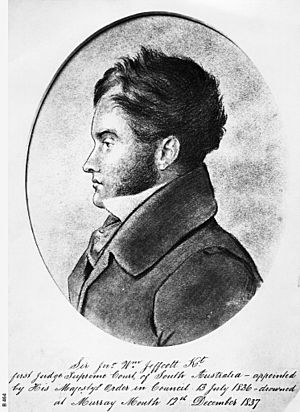John Jeffcott facts for kids
Sir John William Jeffcott (born in 1796 – died 12 December 1837) was a very important person in early Australian history. He was the first judge of the Supreme Court of South Australia. Before that, he was the Chief Justice in Sierra Leone, a country in West Africa.
Contents
Early Life and Career
John William Jeffcott was born in Kerry, Ireland. He studied at Trinity College, Dublin, a famous university. In February 1826, he became a lawyer in England.
In April 1830, Jeffcott became the Chief Justice of the colony of Sierra Leone. He was the only judge there. A big part of his job was to help stop the Transatlantic slave trade, which was a terrible practice of buying and selling people. For his work, he was made a knight in May 1833. This meant he could use "Sir" before his name.
A Difficult Time
While Jeffcott was in England on leave, he had a serious disagreement with another person. This event caused him a lot of trouble. He faced legal issues and lost his important job as Chief Justice in Sierra Leone. His reputation, or good name, was also greatly affected.
However, in May 1836, Jeffcott was offered a new job. He became the first judge of the brand new Colony of South Australia. He had wanted this job since 1834. He never officially had the title "Chief Justice of South Australia" because that title was created much later, in 1856.
Journey to Australia
Jeffcott traveled to Australia in September 1836. He sailed on a ship called the Isabella. He arrived in Hobart, Van Diemen's Land (which is now Tasmania) on 1 January 1837. There, he got engaged to his cousin, Anne Kermode.
He then continued his journey to Adelaide, South Australia, arriving on 21 April 1837.
Helping the New Colony
In South Australia, Jeffcott became a close friend and helper to the Governor, John Hindmarsh. He worked to make things smoother between the Governor and his team. Besides being a judge, Jeffcott was also a member of the South Australian Legislative Council. This council held both the power to make decisions and to create laws for the colony.
On 13 May 1837, Jeffcott led the first Criminal Sessions, which were court hearings for serious crimes. Seven people were brought to trial before a jury. Colonel William Light, who designed Adelaide, was the foreman of this jury. These first sessions were almost the only times Jeffcott actually sat as a judge.
Jeffcott faced another challenge when a ship carrying all his belongings was wrecked. Because of this, he returned to Van Diemen's Land in June 1837. He did not come back to South Australia until September.
Tragic End
Jeffcott left Adelaide for Van Diemen's Land again on 19 November 1837. While he was away, another lawyer named Henry Jickling took over his judge duties.
While waiting for a ship at Encounter Bay, Jeffcott joined a group exploring the Murray Mouth, where the Murray River meets the sea. Sadly, on 12 December 1837, the whaleboat he was in overturned in rough waters because it was too full. Sir John William Jeffcott drowned.
His brother, William Jeffcott, also became a judge in Australia later on.
Legacy
Today, some places in North Adelaide are named after Sir John Jeffcott and his fiancée's family. These include Jeffcott Street and Kermode Street. Also, Jeffcott Chambers, a building for lawyers near the Supreme Court in Adelaide, is named in his honor.
See also
- Judiciary of Australia


